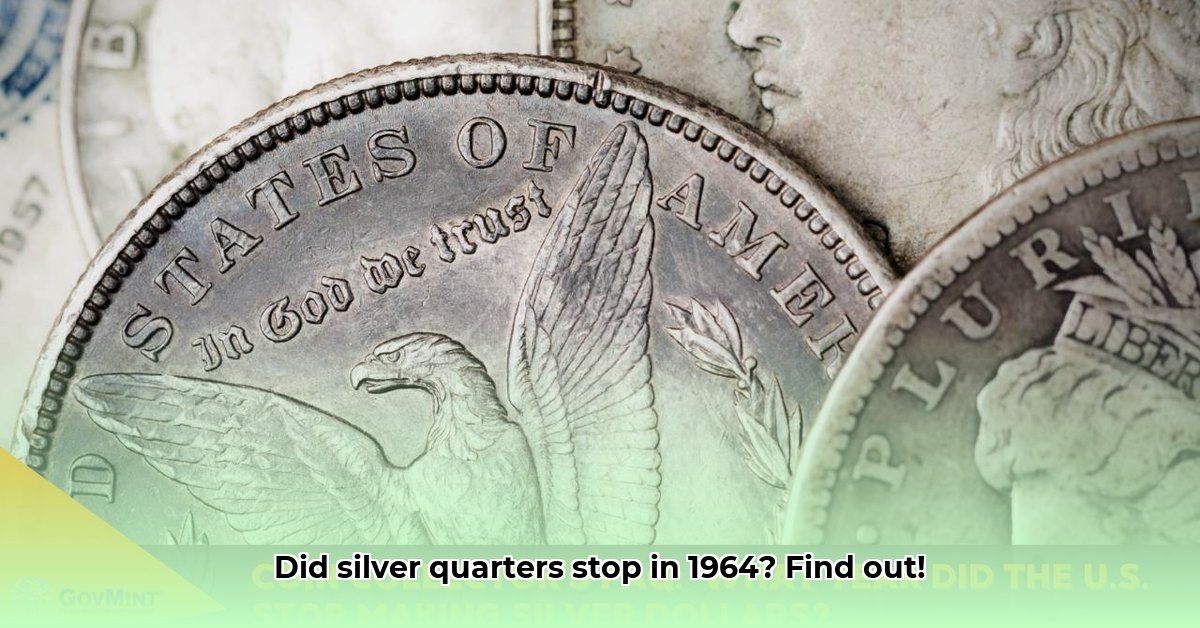
When Did Silver Quarters Stop? 1964 and the Shift in U.S. Coinage
Ever wondered why some quarters feel heavier and shinier than others? The answer lies in 1964, a pivotal year in U.S. numismatic history. This guide provides a structured approach to understanding the change in silver quarter composition and its implications for collectors and investors. We'll cover everything from the historical context to practical strategies for building a successful collection. For more on valuable older coins, check out this guide on silver dollar values.
The End of an Era: The Silver Standard's Demise
Before 1965, U.S. quarters were 90% silver, a legacy of the silver standard. This system directly linked the dollar's value to silver reserves, but rising silver prices made it unsustainable. The government faced a stark choice: devalue the dollar or alter the coin's composition. The latter option was chosen, marking a significant shift in monetary policy and the beginning of the end for silver quarters.
The Introduction of the Clad Quarter: A Cost-Effective Solution
In 1965, the U.S. Mint introduced the "clad" quarter. This new design, featuring a copper core layered with cupro-nickel (a copper-nickel alloy), offered a significantly less expensive alternative to the 90% silver composition. This directly addressed the escalating costs associated with the silver standard, effectively answering the question: "When did silver quarters stop?" – at least, as primarily silver coins.
Pre-1965 vs. Post-1965 Quarters: Two Distinct Investment Opportunities
This change in composition created two distinct categories of quarters, each with different investment implications:
Pre-1965 Quarters ("Junk Silver"): These quarters derive value primarily from their silver content ("melt value"). Their worth fluctuates with the price of silver. However, well-preserved, rare coins can command significantly higher prices. Think of them as historical artifacts with intrinsic value based on material.
Post-1965 Quarters (Numismatic Treasures): These quarters derive value from their collectible nature, encompassing rarity, mint marks, and commemorative designs. Their value is independent of silver prices, influenced instead by condition, mintage figures, and market demand.
Investing in Silver Quarters: A Practical Guide
Investing in silver quarters requires a structured approach. Consider these actionable steps:
Define Your Investment Goals: Are you seeking primarily melt value or numismatic appreciation? Clarity here shapes your investment strategy.
Conduct Thorough Research: Learn to identify pre- and post-1965 quarters. Understanding coin grading systems (e.g., the Sheldon scale) is essential. Higher grades reflect better conditions and higher value.
Diversify Your Portfolio: Don't focus solely on one year or type of coin. Spread your investment across different years and types to mitigate risk associated with market fluctuations.
Risk Assessment Matrix: Navigating the Potential Downsides
Investing in silver quarters, like any investment, carries risks. Understanding these is critical:
| Investment Type | Risk Level | Mitigation Strategies |
|---|---|---|
| Pre-1965 Silver Quarters | Moderate to High | Monitor silver prices; diversify; secure storage |
| Post-1964 Numismatic Quarters | Low to Moderate | Research thoroughly; authenticate coins; diversify your holdings |
| Silver Market Fluctuations | High | Hedge investments; consider alternative precious metals |
Regulatory Implications and Market Dynamics: Beyond the Basics
Understanding the regulatory landscape surrounding coin collecting and investing is essential. Stay informed about any changes in laws or regulations that might impact the value or legality of your investments. Factors influencing the numismatic market include economic conditions, technological advancements, and shifts in collector preferences.
"The numismatic market is dynamic and requires constant monitoring," states Dr. Eleanor Vance, Professor of Economics, University of California, Berkeley. "Understanding market trends is crucial for informed investment decisions."
Calculating the Value of Pre-1965 Silver Quarters: A Detailed Approach
Accurately valuing pre-1965 quarters requires a multifaceted approach:
Determine Melt Value: Calculate the silver weight (coin weight x 0.9) and multiply by the current silver spot price.
Assess Numismatic Value: Professional grading is essential. Higher grades command higher premiums. Rarity also plays a significant role, influencing market demand.
Analyze Market Trends: Research recent auction results and online marketplaces to gauge current prices for similar coins.
By carefully evaluating these three components, one can arrive at a more comprehensive and accurate valuation of pre-1965 silver quarters. Remember, due diligence and a long-term perspective are key to successful numismatic investing.